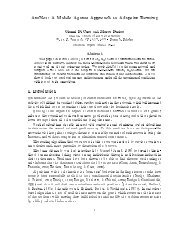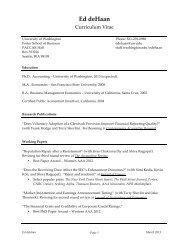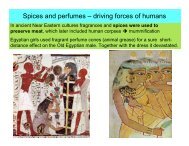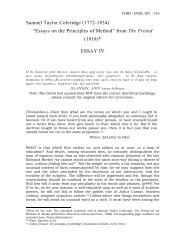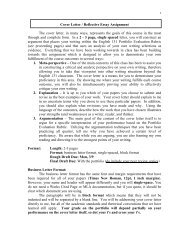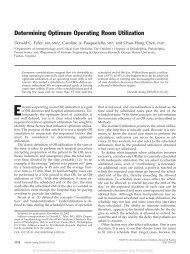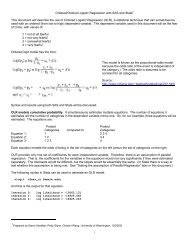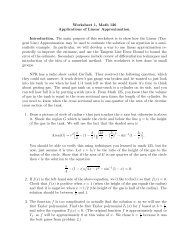Plants with toxic alkaloids - University of Washington
Plants with toxic alkaloids - University of Washington
Plants with toxic alkaloids - University of Washington
You also want an ePaper? Increase the reach of your titles
YUMPU automatically turns print PDFs into web optimized ePapers that Google loves.
Venom <strong>of</strong> snakes and insects is mostly a foreign protein,<br />
sensitivity is related to allergies against casein & ovalbumins<br />
Northern Pacific Rattlesnake<br />
Crotalus viridis oreganus<br />
California to BC, up to 4,5 feet<br />
one <strong>of</strong> the largest and deadliest<br />
Black widow spider<br />
Latrodectus mactans<br />
Females larger & eat full-service<br />
male, nearly blind,<br />
under rim <strong>of</strong> outhouse seats<br />
Very <strong>toxic</strong> venom… death
1. Hormones<br />
Thyroid hormone thyroxin over dosage<br />
from animal product will cause symptoms<br />
<strong>of</strong> iodine poisoning<br />
Insulin<br />
overdosing from animal source will cause<br />
deathlike stage <strong>of</strong> low blood sugar<br />
2. Blood contamination <strong>of</strong> open<br />
wound will <strong>of</strong>ten cause hemolysis in<br />
humans; eel Anguila or tuna blood<br />
Roe <strong>of</strong> Tetraodon or puffer fish is<br />
famous suicide poison in Japan,<br />
barbus, pike and other species is<br />
<strong>of</strong>ten <strong>toxic</strong>
What makes plants <strong>toxic</strong>?<br />
<strong>alkaloids</strong> (nicotin) , oxalate crystals (Areacea), proteins (ricin<br />
Ricinus, abrin (Abrus rosary pea), polypeptides ( phallotoxin <strong>of</strong><br />
Amanitas); amines and non-proteinogenic AAs (Fabaecea),<br />
resins (oily urushiol form poison ivy), minerals (selenium<br />
accumulation in Astralagus), alcohols (cicutoxin in Cicuta water<br />
hemlock, tremetol in Eupatorium snakeroots), glycosides<br />
What does <strong>toxic</strong> mean to us?<br />
Paracelsus: Acting as a toxin or medicine is matter <strong>of</strong> dosage!<br />
Homeopathy: Hahnemann “like cures like”, diluted poisons have<br />
a similar vaccine-like effect comparable to weakened germs<br />
Paul Ehrlich 1898 (“magic bullet”) started studies on anti<strong>toxic</strong><br />
immunity got immunity by feeding abrin & ricin to mice,<br />
…serum develops antibodies against protein. plant toxins
many plants produce just irritants (buttercups, Ginkgo, spurges)<br />
Real toxins are Internally metabolic T. or causing allergic dermatitis<br />
Mushrooms esp amatoxins from genera Amanita, Cortinarius (liver dam)<br />
Alkaloid toxins in: Wisteria, Galanthus (snowdrop), Clivia, Crinum, Amaryllis,<br />
Narcissus, Taxus, Colchicum , Gloriosa<br />
Nitrate poisoning through plants: Amamranthus (pigweeds), Ambrosia<br />
(ragweeds), Datura (Jimson weed) etc. take up large amount <strong>of</strong> nitrate<br />
especially when late fertilization & harvesting in the morning:<br />
nitrate in high concentration is <strong>toxic</strong> poison to mammals<br />
Toxic amines in: Microcystis (blue-green algae), claviceps (ergot),<br />
Phoradendron (mistletoe), Blighia (akee), Lathyrus (sweet peas)<br />
Toxic resins in: Cicuta (water hemlock), Asclepias (milkweeds), Ledum<br />
(Labrador tea), Arum maculatum (lords-& ladies)<br />
Oxalates: Arisaema triphyllum & dracontium(weed, Jack in the pulpit), Calla<br />
palustris (water arum), Lysichiton am.(Skunk cabb), Dieffenbachia<br />
Cardiac glycosides in: Nerium (oleander), Apocynum (dogbane), Scilla<br />
(squill), Convallaria (lily <strong>of</strong> the valley, maybells)
<strong>Plants</strong> that thrill or kill
Laticiferous<br />
systems (lactifers)<br />
are found in the<br />
poppy family, in the<br />
rubber trees (Para<br />
rubber tree and<br />
Castilla elastica),<br />
and in the<br />
Cichorieae <strong>with</strong><br />
Dandelion, lettuce,<br />
hawkweed and<br />
salsify; also present<br />
in milkweeds &<br />
spurges<br />
Lactifers<br />
Latex = milky sap <strong>of</strong> many plants that coagulates on exposure to<br />
air. A complex emulsion in which proteins, <strong>alkaloids</strong>, starchs,<br />
sugars, oils, tannins, resins and gums are found. In most plants,<br />
latex is white, but some have yellow, orange, or scarlet latex.
Lactifers – pipelines for defense and wound healing<br />
Opium for illegal use is <strong>of</strong>ten converted<br />
into heroin, which is less bulky to<br />
smuggle & has a potency <strong>of</strong> twice that <strong>of</strong><br />
morphine. Heroin can be taken by<br />
intravenous injection, intranasally,<br />
smoked and inhaled.<br />
Semen papaveri or poppy seeds contain<br />
a lot <strong>of</strong> oil but little morphine.
<strong>Plants</strong> and Insects<br />
The majority <strong>of</strong> animals is herbivorous = feeds on plants! Spines, thorns,<br />
cuticle, camouflage, repelling smell, taste & deadly toxins are the<br />
reason that plants keep dominating (95 %!) the planet’s biomass.<br />
Herbivores feed only on one to a few plant species because they can only<br />
overcome a few <strong>of</strong> the defense mechanisms. Even humans (only herbi species<br />
that cooks & selects population features by breeding) feed only on very small<br />
number <strong>of</strong> plants out <strong>of</strong> the 400 000 species on the planet. E.g. we feed only on<br />
the petioles <strong>of</strong> rhubarb leaves & discard the oxalate-rich blades.<br />
Milky caustic, <strong>toxic</strong> juice flows<br />
through many plants <strong>with</strong><br />
lactifers (pressurized vessels<br />
running in parallel <strong>with</strong> watertransporting<br />
xylem & sugartransporting<br />
phloem). Occurring<br />
in Apocynaeceae, Euphorbiaecea,<br />
Asteraecea, Caricaceae, Moracea
<strong>Plants</strong> help snails to defend against insects!<br />
Snails are slow animals, both in the speed <strong>of</strong> their locomotion & nervous<br />
transmission. How do these sitting ducks defend against ants.<br />
When you poke a slug<br />
<strong>with</strong> a toothpick & wiggle<br />
it, the slug will produce a<br />
rubbery blob around the<br />
tip. Ant would be muzzled;<br />
fixed mandibles<br />
How do snail eggs survive from being eaten?<br />
They are protected by an isoprenoid= terpene called miriamine.<br />
R: Thomas Eisner “ For love <strong>of</strong> insects” Harvard <strong>University</strong> Press, 2003
Can <strong>Plants</strong> produce a Polymer muzzle for<br />
Insects?<br />
1905 H Kniep carried out classical experiment on chemical defense in plants.<br />
By repeated poking the midvein <strong>of</strong> Euphorbias he drained/milked them &<br />
found them now being eaten by snails.<br />
Kniep did not know that some insects have practiced his method<br />
regularly to avoid being poisoned or muzzled alive!<br />
Drain the lactifer<br />
defense chemicals<br />
or get muzzled !!!<br />
R: Thomas Eisner “ For love <strong>of</strong> insects” Harvard <strong>University</strong> Press, 2003
Papaveracea – Poppy family -Opium<br />
Opium lachryma papaveris) is the dried<br />
latex from the opium poppy Papaver<br />
somniferum containing up to 12%<br />
morphine, adjusted for medicine to 10 %<br />
(Europe).<br />
Opium for illegal use is <strong>of</strong>ten converted<br />
into heroin, which is less bulky to<br />
smuggle & has a potency <strong>of</strong> twice that <strong>of</strong><br />
morphine. Heroin can be taken by<br />
intravenous injection, intranasally,<br />
smoked and inhaled.<br />
Semen papaveri or poppy seeds contain<br />
a lot <strong>of</strong> oil but little morphine.
Lactuca virosa or German opium<br />
Semen papaveri or poppy seeds contain<br />
a lot <strong>of</strong> oil but little morphine.
Ranunculin
: Ranunculaeacea – buttercup family<br />
Buttercups, anemones, clematis and hellebores contain the irritant<br />
glycoside ranunculin. Upon hydrolysis in mucous epithelia & skin<br />
it releases protoanemonin that rapidly dimerizes to anemonin, a<br />
harmless compound found in dried materials.
Creeping buttercup<br />
Ranunculus repens<br />
Protoanemonin in fresh sap<br />
irritating to skin & mucuous<br />
membranes causes blisters<br />
diarrhea to neural paralysis<br />
Pasque flower Anemone<br />
occidentalis / patens<br />
Touching the plant may cause<br />
blisteringEating the plant <br />
bloody vomiting and diarrhea
<strong>Plants</strong> <strong>with</strong> Cyanogenic Glycosides<br />
One <strong>of</strong> the most dangerous<br />
plants.<br />
However, the cause is<br />
unknown!
Doll’s Eyes Actaea pachypodia<br />
Actaea pachypoda (Doll's-eyes, White<br />
Baneberry) is a herbaceous perennial plant in the<br />
family Ranunculaceae, native to eastern North<br />
America. The berries contain cardiogenic toxins<br />
which can have an immediate sedative effect on<br />
human cardiac muscle tissue, and are the most<br />
poisonous part <strong>of</strong> the plant. Ingestion <strong>of</strong> the<br />
berries can lead to cardiac arrest and death.<br />
The Doll’s eye plant, also known by<br />
the equally unsettling name “white<br />
baneberry.” Just in case you were<br />
actually thinking <strong>of</strong> eating this thing,<br />
those eyeballs are highly poisonous.
Salicin - a glycoside <strong>of</strong><br />
salicylic acid from<br />
willows & meadowsweet<br />
related to the drug<br />
aspirin<br />
Glycosides for temporary detoxification<br />
Aglycoside is a molecule in which (1) a sugar is<br />
bound to (2) a non-carbohydrate moiety: some<br />
other organic molecule. The sugar group is then<br />
known as (1) the glycone and the non-sugar<br />
group as (2) the aglycone or genin part <strong>of</strong> the<br />
glycoside.<br />
<strong>Plants</strong> store chemicals including toxins in the<br />
form <strong>of</strong> inactive glycosides. These can be<br />
activated by hydrolysis, which causes the sugar<br />
part to break <strong>of</strong>f, making the chemical ready to<br />
act. Also in animals and humans, poisons are<br />
<strong>of</strong>ten bound to sugar molecules as part <strong>of</strong> their<br />
detoxification.
Cyanogenic glycosides Amygdaline
Choke cherry<br />
Prunus virginiana<br />
Seeds, dried and fresh leaves,<br />
bark contain deadly cyanogenic<br />
glycosides such as amygdalin<br />
and prunasin<br />
Loss <strong>of</strong> voice, respiratory<br />
failure , spasms, coma , death<br />
Neurotoxins cause crazy<br />
behavior = locoism, lifestock<br />
may seek locoweeds instead <strong>of</strong><br />
healthy food plan… death
<strong>Plants</strong> <strong>with</strong> Cyanogenic Glycosides
<strong>Plants</strong> <strong>with</strong> Cyanogenic Glycosides
<strong>Plants</strong> <strong>with</strong> Cardiac Glycosides
<strong>Plants</strong> <strong>with</strong> Cardiac Glycosides
<strong>Plants</strong> <strong>with</strong> Cardiac Glycosides<br />
Nerium oleander is an evergreen shrub in the<br />
dogbane family Apocynaceae, <strong>toxic</strong> in all its<br />
parts. Name oleander comes from its<br />
superficial resemblance to the unrelated olive<br />
Olea europea leaf<br />
Among the cardiac glycosides are<br />
oleandrin and oleandrigenin, which are<br />
known to be <strong>toxic</strong> when ingested. Dogs and<br />
humans, are relatively sensitive to the effects<br />
<strong>of</strong> cardiac glycosides and the clinical<br />
manifestations <strong>of</strong> "glycoside in<strong>toxic</strong>ation”.
Suicide Tree Cerbera odollam – cardiac glycosides<br />
In the SW Indian coastlands lives a relative <strong>of</strong> Oleander<br />
The fruit looks like a small mango, <strong>with</strong> a green shell<br />
enclosing an ovoid kernel measuring approximately 2 cm<br />
×1.5cm. On exposure to air, the white kernel turns<br />
violet, then dark grey, and ultimately brown, or black. The<br />
plant as a whole yields a milky, white latex.<br />
The kernels contain cerberin a potent toxin related to<br />
digoxin, a cardiac glycoside poison found in<br />
foxglove. It blocks the calcium ion channels in heart<br />
muscle, causing disruption <strong>of</strong> the heart beat. This is fatal.<br />
Cerberin is difficult to detect in autopsies and its<br />
taste can be masked <strong>with</strong> strong spices. Therefore it<br />
is <strong>of</strong>ten used in homicide and suicide in India.<br />
In Madagascar belief in the accuracy <strong>of</strong> trial by<br />
ordeal using this poison was so strongly held that<br />
innocent people did not hesitate to subject<br />
themselves to it
Unusual Poisons<br />
The slobber weed: Pilocarpus pennatifolius stimulates the<br />
salivary glands much more than the betel nut Areca catechu<br />
(the nut causing red saliva that stains the street <strong>of</strong> Asia). Here<br />
the secretion becomes so powerful that it interferes <strong>with</strong><br />
speech (ideal for political opponents!). Unfortunately, the<br />
drooling (up to 2 pints) is followed by nausea & dizziness.<br />
Drooling is also caused by the pencil tree extract. Pilocarpine<br />
(an alkaloid used for glaucoma) is used to treat dry mouth &<br />
also to stimulate sweat glands.<br />
Pilocarpus: approx13<br />
species in the Rutaceae,<br />
from the tropics <strong>of</strong> S Amer.<br />
The Suicide Tree: Cerbera odollam is a relative <strong>of</strong><br />
Madagascan arrow poison tree Cerbera tanghin ( nuts that<br />
are used in trials by ordeal). The tree grows at the SW coast<br />
<strong>of</strong> India and has white jasmine-scented flowers. The nuts<br />
look like green mangos & the white meat inside is full <strong>of</strong><br />
cardiac glycosides that stop the heart <strong>of</strong> a human <strong>with</strong>in 4<br />
hours. Widows & other religiously inclined people use these<br />
nuts (mashed nut meat <strong>with</strong> brown sugar) as their last meal.<br />
Also used to poison people since it has no bad taste & a<br />
delayed action.
Sausage Tree Kigelia ssp – cardiac glycosides<br />
Kigelia is a 20 m tall tree <strong>of</strong> in the Bignoniaceae<br />
which occurs throughout tropical Africa.<br />
Sausage Tree refers to the long, sausage-like fruit.<br />
The fruit is a woody berry 30–100 cm long it weighs<br />
between 5–10 kg, and hang down on long, rope-like<br />
peduncles. The fruit pulp is fibrous and pulpy, and<br />
contains numerous seeds. It is eaten by several<br />
species <strong>of</strong> mammals, including Baboons, Bushpigs,<br />
Savannah Elephants, Giraffes, Hippopot.<br />
For humans the fresh fruit is poisonous and<br />
strongly purgative. In African herbal medicine, the<br />
fruit is used as a cure for a wide range <strong>of</strong> ailments:<br />
rheumatism, snakebites, evil spirits, syphilis,<br />
and even tornadoes. Fruit are prepared for<br />
consumption by drying, roasting or fermentation. An<br />
alcoholic beverage similar to beer is also made<br />
from it. The fresh fruit is poisonous and strongly<br />
purgative.
Ericaeceae: Rhododendrons, Kalmia laurels
<strong>Plants</strong> <strong>with</strong> serious cardiac effects: Pontic honey?
Biological warfare in the history <strong>of</strong> our World<br />
Indians invented a special assassination weapon- poison<br />
maidens. They send dancing girls contact <strong>with</strong> whom = death.<br />
Alex the Great was a chosen recipient <strong>of</strong> such a girl in 327 BC.<br />
Pontic honey = was used by the ancient Georgians (Colchis,<br />
Pontus) to poison Pompey’s Roman soldiers which were<br />
pursuing Mithridates to the Crimea. Mithridates was a<br />
Greek king & a leading <strong>toxic</strong>ilologist. He designed the<br />
universal antidote to prevent himself from being poisoned.<br />
When he killed himself <strong>with</strong> poison – his end was painful.<br />
World war 1 & 2: Churchill uses poisonous gas against the<br />
Kurds when Britain occupies Iraq. Later repeated by<br />
Saddam Hussein after armistice <strong>with</strong> US. During WWII<br />
CSS/CIA tries to pacify Hitler by injecting female hormones<br />
into his vegies (he was a belligerent vegetarian and antialcoholic).<br />
2002 Pentagon develops mind-altering pacifiing<br />
volatiles that can be sprayed or shot <strong>with</strong> bullets/granates.<br />
This can be used against a population mixed <strong>with</strong> terrorists.
<strong>Plants</strong> <strong>with</strong> <strong>toxic</strong> Saponins<br />
The primary function <strong>of</strong> saponins is to protect the plant from microbial and insect attack.<br />
In mammals, including humans who consume saponins, they frequently create pores in<br />
the gut lining, thereby increasing intestinal permeability. If they enter the<br />
bloodstream in sufficient concentrations, they cause hemolysis
<strong>Plants</strong> <strong>with</strong> Saponins: Soap nut Sapindus
<strong>Plants</strong> <strong>with</strong> <strong>toxic</strong> Saponins: ivy Hedera helix
<strong>Plants</strong> <strong>with</strong> <strong>toxic</strong> Saponins: Solanum tuberosum<br />
Some notorious non-edible nightshades include<br />
tobacco, petunias, jimson weed, mandrake, and<br />
deadly nightshade. The family also comprises well<br />
known food plants such as potatoes, tomatoes,<br />
green peppers, chili peppers, eggplants and<br />
tomatillos.. Genetic testing <strong>of</strong> proved a single<br />
origin for potatoes in the area <strong>of</strong> present-day<br />
southern Peru from a species in the Solanum<br />
brevicaule where they were domesticated 7,000–<br />
10,000 years ago.<br />
Wild potato contain sufficient saponins <strong>of</strong> the<br />
steroid type to warrant caution.<br />
Some potato varieties produce small green fruits that resemble<br />
green cherry tomatoes, each containing up to 300 true seeds.<br />
Potato fruit contains large amounts <strong>of</strong> the <strong>toxic</strong> alkaloid<br />
solanine and is therefore unsuitable for consumption. All new<br />
potato varieties are grown from seeds, also called "true seed" or<br />
"botanical seed" to distinguish it from seed tubers.
<strong>Plants</strong> <strong>with</strong> <strong>toxic</strong> Saponins: Corn cockle Agrostemma<br />
Agrostemma is a<br />
genus <strong>of</strong> annual plants<br />
in the Caryophyllaceae<br />
family, containing the<br />
species known as<br />
corncockles. Its bestknown<br />
member is A.<br />
githago, the Common<br />
Corncockle.<br />
Saponin-containing<br />
seeds <strong>of</strong> Agrostemma<br />
spoil grain crop by<br />
bitter taste.
<strong>Plants</strong> <strong>with</strong> <strong>toxic</strong> Saponins: Pokeweed
<strong>Plants</strong> <strong>with</strong> <strong>toxic</strong> Saponins
Ilex Holly unknown hemolytic agent – saponin?
<strong>Plants</strong> <strong>with</strong> <strong>toxic</strong> Saponins
<strong>Plants</strong> that can be used as soap ersatz<br />
<strong>Plants</strong> that produce foam do not contain Na salts <strong>of</strong> fatty acids ( the<br />
manmade soap) but saponins - foaming terpenoids<br />
Agave root, leaves & stem<br />
Jujuba or Zizyphus fruit<br />
Morning glory Ipomea plant ashes<br />
Pigweed Chenopodium root<br />
Pokeweed Phytolacca fruit<br />
Soapberry Sapindus berry<br />
Soapwort Saponaria root<br />
Yucca root<br />
Wild gourd Cucurbita fruit<br />
quinoa seeds<br />
lentil Lens culinaris seeds<br />
potatoes Solanum tuberosum fruit<br />
Shepherdia soapberry is bitter<br />
Zizyphus jujuba<br />
The role <strong>of</strong> the foaming quality <strong>of</strong> saponins in plants is yet to be<br />
established. It could be that they play a role to stabilize plant-derived<br />
li lik lt t
Alkaloid definition *<br />
3000 alk. in 4000 species <strong>of</strong> fungi and plants (ca. 40 in animals)<br />
Fabaecea, Solanaecea, Rubiaceae, Apiaecea, Piperaecea<br />
Four features <strong>of</strong> <strong>alkaloids</strong><br />
- Contain N<br />
- have alkaline reaction (pH>7)<br />
- bitter taste<br />
- <strong>of</strong>ten affect CNS <strong>of</strong> animals<br />
Taxus b. taxol to fight ovarian/breast cancer<br />
Ephedra ephedrine to fight bronchial asthma, bronchitis<br />
Rauwolfia/reserpin tranquilizer (schizo), red. blood pressure<br />
Vinca rosea vinblastine against leucemia (cancer. blood cells)<br />
Pilocarpus pilocarpine relieves intraocular pressure (glaucoma)
Papaveracea – Poppy family -Opium<br />
Opium lachryma papaveris) is the dried<br />
latex from the opium poppy Papaver<br />
somniferum containing up to 12%<br />
morphine, adjusted for medicine to 10 %<br />
(Europe).<br />
Morphine is a potent opiate analgesic<br />
medication. It was the first alkaloid to be<br />
isolated in 1804 by Friedrich Sertürner,<br />
a “Apotheker” in Halle (Germany), first<br />
distributed by same in 1817, and first<br />
commercially sold by Merck in 1827,<br />
which at the time was a single small<br />
chemists' shop in Darmstadt.<br />
Morphine is regarded as the gold standard <strong>of</strong> analgesics to relieve severe, agonizing<br />
pain. Like other opioids, such as oxycodone, hydromorphone, and diacetylmorphine<br />
(heroin), it acts directly on the CNS. Morphine has a high potential for addiction;<br />
tolerance and psychological dependence develop rapidly,
Poison Hemlock<br />
Conium maculatum :<br />
Piperidine alkaloid coniine<br />
killed Socrates<br />
Pr<strong>of</strong>use salivation, respir.<br />
Muscle paralysis, bad death<br />
Coniinne can be steamdistilled<br />
like essential oil<br />
Water Hemlock<br />
Cicuta douglasii (Western)<br />
cicutoxin alcohol<br />
stomach pain, cramps,<br />
salivation, delirium and …<br />
death<br />
<strong>Plants</strong> <strong>with</strong> <strong>toxic</strong> Alkaloids
Poison Hemlock<br />
Conium maculatum :<br />
Piperidine alkaloid coniine killed<br />
Socrates<br />
Pr<strong>of</strong>use salivation, respir.<br />
Muscle paralysis, bad death<br />
Coniinne can be steam-distilled<br />
like essential oil<br />
Water Hemlock<br />
Cicuta douglasii (Western)<br />
cicutoxin alcohol<br />
stomach pain, cramps,<br />
salivation, delirium and … death
Water Hemlock<br />
Cicuta douglasii (Western)<br />
Cicuta, water hemlock, is<br />
a perennial herbaceous<br />
plant in the family<br />
Apiaceae, which grows up<br />
to 2.5 meter tall<br />
cicutoxin alcohol<br />
stomach pain, cramps,<br />
salivation, delirium and …<br />
death
<strong>Plants</strong> <strong>with</strong> <strong>toxic</strong> <strong>alkaloids</strong>: Solanum tuberosum<br />
Some notorious non-edible nightshades include<br />
tobacco, petunias, jimson weed, mandrake, and<br />
deadly nightshade. The family also comprises well<br />
known food plants such as potatoes, tomatoes,<br />
green peppers, chili peppers, eggplants and<br />
tomatillos.. Genetic testing <strong>of</strong> proved a single<br />
origin for potatoes in the area <strong>of</strong> present-day<br />
southern Peru from a species in the Solanum<br />
brevicaule where they were domesticated 7,000–<br />
10,000 years ago.<br />
Wild potato contain sufficient saponins <strong>of</strong> the<br />
steroid type to warrant caution.<br />
Some potato varieties produce small green fruits that resemble<br />
green cherry tomatoes, each containing up to 300 true seeds.<br />
Potato fruit contains large amounts <strong>of</strong> the <strong>toxic</strong> alkaloid<br />
solanine and is therefore unsuitable for consumption. All new<br />
potato varieties are grown from seeds, also called "true seed" or<br />
"botanical seed" to distinguish it from seed tubers.
Mom, why are lupines <strong>toxic</strong>?<br />
Due to association <strong>with</strong> N-fixing Rhizobium bacteria Lupines thrive in dry open<br />
fields and prairie/wood area. Horticultural variety <strong>of</strong> lupine has been a favorite<br />
<strong>of</strong> many gardeners. However …<br />
Signs <strong>of</strong> poisoning: labored breathing (snored) in sheep, <strong>with</strong><br />
depression , salivation, head pressing tremors, seizures and coma,<br />
Death may be preceded by no struggling or alternatively, by<br />
violent attacks on other animals. Signs may appear as early as one<br />
hour after ingestion or as late as 24 hours after consumption. Death<br />
may occur <strong>with</strong>in one day or several days (respiratory paralysis).<br />
<strong>of</strong>loxacin<br />
15 quinolizidine + some piperidine <strong>alkaloids</strong> and other types <strong>of</strong> <strong>alkaloids</strong><br />
have also been isolated from species <strong>of</strong> Lupinus. They are present in
<strong>toxic</strong> <strong>alkaloids</strong> larkspur Delphinium<br />
Larkspurs or Delphinium species are a widespread<br />
group <strong>of</strong> poisonous plants in the Western US killing from<br />
5 to 15% <strong>of</strong> the cattle on N Am mountain rangelands. Of<br />
the 40 diterpenoid larkspur <strong>alkaloids</strong>, the most <strong>toxic</strong><br />
is methyllycaconitine (MLA).<br />
The toxins are at least two <strong>alkaloids</strong> called delphinium<br />
<strong>alkaloids</strong> (0.1 to 0.6 % DWT) causing a neuro-muscular block <strong>with</strong><br />
tremor and final collapse, bloating and death. The main victims are<br />
cows, horses and sheep rarely eat enough to suffer.<br />
Larkspur <strong>alkaloids</strong> act on cattle in a similar way as which more<br />
famous alkaloid acts on you and other mammals?<br />
…………………………….
<strong>toxic</strong> <strong>alkaloids</strong> locoweeds<br />
Locoweed is a widespread group <strong>of</strong> poisonous plants in the Western US.Among<br />
530 species <strong>of</strong> the Fabaceae Astralagus and Oxytropis: there are 11<br />
causing locoism. Populations are cyclic increasing in wet years <br />
catastrophic appearances.<br />
The toxin is an alkaloid called<br />
swainsonine (0.01 to 0.3 % DWT) that<br />
inhibits the mannosidase enzymes resulting in<br />
unmetabolizable glycoproteins = hybridtype<br />
glycans assocoated <strong>with</strong> neurological<br />
damage, depression, in-coordination,<br />
decreased libido and fertility, abortions,<br />
decreased appetite etc.<br />
Swainsonine is an anti-cancer drug <strong>with</strong><br />
potential for treating glioma (brain tumor) and<br />
gastric carcinoma, bone marrow
Unusual Poisons<br />
The slobber weed: Pilocarpus pennatifolius stimulates the<br />
salivary glands much more than the betel nut Areca catechu<br />
(the nut causing red saliva that stains the street <strong>of</strong> Asia). Here<br />
the secretion becomes so powerful that it interferes <strong>with</strong><br />
speech (ideal for political opponents!). Unfortunately, the<br />
drooling (up to 2 pints) is followed by nausea & dizziness.<br />
Drooling is also caused by the pencil tree extract. Pilocarpine<br />
(an alkaloid used for glaucoma) is used to treat dry mouth &<br />
also to stimulate sweat glands.<br />
Pilocarpus: approx13<br />
species in the Rutaceae,<br />
from the tropics <strong>of</strong> S Amer.<br />
The Suicide Tree: Cerbera odollam is a relative <strong>of</strong><br />
Madagascan arrow poison tree Cerbera tanghin ( nuts that<br />
are used in trials by ordeal). The tree grows at the SW coast<br />
<strong>of</strong> India and has white jasmine-scented flowers. The nuts<br />
look like green mangos & the white meat inside is full <strong>of</strong><br />
cardiac glycosides that stop the heart <strong>of</strong> a human <strong>with</strong>in 4<br />
hours. Widows & other religiously inclined people use these<br />
nuts (mashed nut meat <strong>with</strong> brown sugar) as their last meal.<br />
Also used to poison people since it has no bad taste & a<br />
delayed action.
Speckled Locoweed<br />
Astralagus lentiginosous<br />
Neurotoxins cause<br />
crazy behavior = locoism,<br />
lifestock may seek locoweeds<br />
instead <strong>of</strong> healthy food plants<br />
nerve cells damaged ,<br />
bad death<br />
Poison vetch<br />
Astralagus pectinatus<br />
Accumulates selenium<br />
“blind staggers” in lifestock<br />
…death
Teratogens<br />
Teratology is the study <strong>of</strong> abnormalities <strong>of</strong><br />
physiological development. Narrowly thought <strong>of</strong> as the<br />
study <strong>of</strong> birth defects, it is much broader than that, taking in<br />
other developmental stages, such as puberty; and other life<br />
forms, such as plants. The term was popularized in the 1960s<br />
by Dr. David W. Smith <strong>of</strong> the <strong>University</strong> <strong>of</strong> <strong>Washington</strong><br />
Medical School, who became known in 1973 for the discovery<br />
<strong>of</strong> Fetal alcohol syndrome.<br />
Drugs and medications: tobacco, caffeine, drinking alcohol (ethanol), isotretinoin (13cis-retinoic<br />
acid, Roaccutane) = a anti ACNE medication, temazepam (Restoril;<br />
Normisson), nitrazepam (Mogadon), nimetazepam (Ermin), aminopterin, coumarin,<br />
diethylstilbestrol, phenytoin<br />
Environmental chemicals: polychlorinated biphenyls (PCBs), polychlorinated<br />
dibenzodioxins a.k.a dioxin, polychlorinated dibenz<strong>of</strong>urans (PCDFs), ,<br />
organic mercury, ethidium bromide, etc.<br />
Ionizing radiation: atomic fallout, diagnostic x-rays, radiation<br />
Infections: cytomegalovirus, herpes virus, parvovirus B19, rubella virus (German<br />
measles), syphilis, toxoplasmosis, encephalitis virus.<br />
Metabolic imbalance: alcoholism, diabetes, folic acid deficiency, iodine<br />
deficiency,hyperthermia, phenylketonuria, rheumatism
Teratogenic <strong>Plants</strong><br />
Teratogens cause abnormalities <strong>of</strong> physiological<br />
development; which in mammals early appear as<br />
birth defects . Approx. 1 % <strong>of</strong> all livestock in US<br />
rangeland shows birth defects from teratogenic plants.<br />
Western False Hellebore = Corn lily = Veratrum<br />
californicum causes poisoning in sheep, cattle and goat.<br />
Identified teratogens are the steroidal <strong>alkaloids</strong><br />
cyclopamine, cycloposine and jervine interfering <strong>with</strong><br />
neurological embryo development causing lambs <strong>with</strong><br />
monkeyfaces and one eye (cyclopsis)<br />
Lupines Lupinus ssp Conium and Nicotiana contain<br />
piperidine & quinolizidine <strong>alkaloids</strong> inducing birth<br />
defects in the form <strong>of</strong> palate cleft (lips). Quinolizidine<br />
alkaloid anagyrine causes birth defects in cattle. Other<br />
piperidine <strong>alkaloids</strong> affect birth defects in in sheep and goats.<br />
Coniine & anabasine (from Nicotiana) cause similar effects in<br />
swine, gaots, sheep and cattle.
Rhubarb RheumXcultorum<br />
malic acid in petiole, oxalic<br />
acid + anthraquinone glycos.<br />
In blades intern bleeding<br />
lethal<br />
Corn lily Veratrum viride/<br />
protoanemonin – typical<br />
highly <strong>toxic</strong> <strong>alkaloids</strong> <br />
malformations, cramps<br />
Pokeweed Phytolacca amer<br />
stomach pain, cramps,<br />
convulsions espec. From<br />
root
Oxalate-rich plants include sorrel<br />
Rumex acetosa, several Oxalis<br />
species, the root & leaves <strong>of</strong><br />
rhubarb and buckwheat .<br />
Leaves <strong>of</strong> the tea plant (Camellia<br />
sinensis) contain among the<br />
greatest measured concentrations<br />
<strong>of</strong> oxalic acid relative to other<br />
plants. However the infusion<br />
beverage typically contains only<br />
low to moderate amounts per<br />
serving<br />
Also several vegetables like<br />
rhubarb or taro Colocasia<br />
esculenta have high contents <strong>of</strong><br />
oxalate<br />
<strong>Plants</strong> <strong>with</strong> <strong>toxic</strong> Oxalates
<strong>Plants</strong> <strong>with</strong> <strong>toxic</strong> Oxalates: Skunk cabbage family<br />
Araceae are a family <strong>of</strong><br />
monocotyledonous flowering plants<br />
<strong>with</strong> an inflorescence called a<br />
spadix. The spadix is usually<br />
accompanied by, and sometimes<br />
partially enclosed in, a spathe or<br />
leaf-like bract. Also known as the<br />
Arum family, as aroids or skunk<br />
cabbage family.<br />
Alocasia, Arisaema, Colocasia,<br />
Dieffenbachia, Philodendron contain<br />
calcium oxalate crystals in the form <strong>of</strong><br />
raphides. Raphides are needle-shaped<br />
crystals <strong>of</strong> calcium oxalate/ When<br />
consumed, these may cause edema,<br />
accompanied by painful stinging and<br />
burning to the mouth and throatfor<br />
up to two weeks.<br />
Skunk cab<br />
Anthurium<br />
inflorescense<br />
raphides<br />
Monstera<br />
Calla
Oxalates: Skunk cabbage family<br />
Harmless oxalate<br />
crystals in onion peels<br />
Les raphides dangereux
Rhubarb RheumXcultorum<br />
malic acid in petiole, oxalic<br />
acid + anthraquinone glycos.<br />
In blades intern bleeding<br />
lethal<br />
Corn lily Veratrum viride/<br />
protoanemonin – typical<br />
highly <strong>toxic</strong> <strong>alkaloids</strong> <br />
malformations, cramps<br />
Pokeweed Phytolacca amer<br />
stomach pain, cramps,<br />
convulsions espec. From<br />
root
<strong>Plants</strong> <strong>with</strong> <strong>toxic</strong> amino acids and proteins<br />
Lectins are sugar-binding proteins<br />
that are highly specific for their<br />
sugar moieties. They moderate<br />
biological recognition like viruses<br />
use lectins to attach themselves to<br />
the cells.<br />
Plant lectins like arbrin and ricin<br />
attach themselves to the<br />
glycoproteins at the surface <strong>of</strong><br />
erythrocytes and cause them to<br />
clump together hemagglutinins<br />
Peter Hermann Stillmark in 1888 (<strong>University</strong> <strong>of</strong> Dorpat) isolated ricin, an extremely <strong>toxic</strong><br />
hemagglutinin, from seeds <strong>of</strong> the castor plant (Ricinus communis) The first lectin to be<br />
purified on a large scale and available on a commercial basis was concanavalin A from<br />
the jack bean.
<strong>Plants</strong> <strong>with</strong> <strong>toxic</strong> amino acids and proteins<br />
Also several vegetables like<br />
rhubarb or taro Colocasia<br />
esculenta have high contents <strong>of</strong><br />
oxalate
<strong>Plants</strong> <strong>with</strong> <strong>toxic</strong> amino acids and proteins<br />
Also several vegetables like<br />
rhubarb or taro Colocasia<br />
esculenta have high contents <strong>of</strong><br />
oxalate
<strong>Plants</strong> <strong>with</strong> <strong>toxic</strong> amino acids and proteins
Arrow Poisons<br />
Curare: Alkaloid d-turbocurarin from vine Chondrodendrum tomentosum is a<br />
fast acting muscle relaxant. It has to enter the blood stream , so meat is safe to<br />
eat if your gut is ok. The prey is not dead but paralyzed & experiences the<br />
whole scene <strong>with</strong> P13 terror. Victims die after hours when curarin reaches the<br />
lungs (artificial respiration keeps them alive). It does not relive the pain but<br />
prevents patients from thrashing around.<br />
Strychnine: from tree Strychnos nux-vomica acts similar but acts faster<br />
Kombe: from the African vine Strophantus kombe contains a cardiac glycoside<br />
that slows the pulse in low doses. Polluted area <strong>of</strong> meat must be discarded.<br />
Arrow plant Acokantherea is an SAfrican shrub <strong>with</strong> juice that contains<br />
cardiac glycoside . Was smeared on arrows and weapons and on fruits <strong>of</strong><br />
punture vine as as poisonous land mine.<br />
Upas tree: Antiaris in the mulberry tree family is an Asian tree <strong>with</strong> brk and<br />
leaves filled <strong>with</strong> a <strong>toxic</strong> sap. Was suspected to exude deadly fumes to people<br />
close to him, but no volatile toxins were found. Juice was used as aroow poison<br />
and also in flaming fire lances thrown by the Chinese army.
Delayed Poisons<br />
Coyotillo berries: contain a neurotoxin that acts only after<br />
a few days. Then the victim – men or animal – would lose<br />
control over their legs (quadriplegia). Coyotillo is the shrub<br />
Karwinskia humboldtiana in the buckthorn family that<br />
thrives in the dry valleys <strong>of</strong> Texas, Mexico and New<br />
Mexico. Ideal for murder mysteries & assasinations.<br />
Ergot: the alkaloid ergotamine from the parasitic fungus<br />
Claviceps purpurea infects rye grains in humid conditions. It<br />
might give you a pleasant feeling first (hallcinogen lysergic<br />
acid) but then it constricts blood vessels , causes nausea,<br />
seizures uterine contractions & gangrene (limbs falling <strong>of</strong>f).<br />
Polluted area <strong>of</strong> meat must be discarded. Rinsing grains <strong>with</strong><br />
salt solution will kill the fungus.<br />
Cortinarius mushroom small shiitake-like mushrooms are<br />
highly <strong>toxic</strong> & show the Orellanus syndrome: a damaged kidney<br />
function after a delay <strong>of</strong> several days. Seizures , pain and kidney<br />
& liver damage & <strong>of</strong> ten death are the results <strong>of</strong> late treatment.
Deadly Poisons<br />
Sandbox tree Hura crepitans: A member <strong>of</strong> the<br />
Euphorbiaecea from the West Indies was used as an arrow<br />
poison by cannibalistic indians at the time <strong>of</strong> Columbus.<br />
The fruits explode <strong>with</strong> a loud bang and shatter poisonous<br />
seeds at a distance <strong>of</strong> up to 100 m dynamite tree<br />
Ratbane : Dichapetalum cymosum is flowering tree from<br />
west Africa. Several plants produce the same toxin Sodium<br />
fluoroacetate. This toxin is taste & odorless & some<br />
smart US boys in the 1940s tried to poison coyotes.<br />
However, the poison is not catabolized and poisons the<br />
whole foot chain the poison that keeps on killing. EPA<br />
banned Compound 1080 in 1972. US firms also supplied<br />
Saddam Hussein’s Iraq.<br />
Larkspur Delphinium is a buttercup like monkshood<br />
Aconitum napellus . Like the neuro<strong>toxic</strong> alkaloid aconitin,<br />
larkspurs also contain a deadly alkaloid in their foliage.
Stinging Hairs <strong>of</strong> the Urticas<br />
For a long time we did not know what caused<br />
the stinging sensation <strong>of</strong> Urtica dioica? It was<br />
first shown that formic acid was inside the hairs<br />
but that alone does not cause such effects!<br />
Urtica dioica is harmless when compared <strong>with</strong> tropical<br />
nettles like Urtica stimulans (Java) & Urtica crenulata<br />
(India) & the worst Urtica urentissima (Timor) which<br />
also cause skin irritations but in addition affect the nervous<br />
system in the area <strong>with</strong> paralytic cramps & permanent<br />
damage to nerves. Dogs refuse to search for game after<br />
experiencing the burning sensation <strong>of</strong> nettels, geese seem<br />
to be insensitive, larvae <strong>of</strong> some butterfly too<br />
There are other plant families <strong>with</strong> stinging hairs<br />
Hydrophyllaeceae Wigandia urens , Euphorbiaceae<br />
Jatropha urens have stinging hairs while many members<br />
<strong>of</strong> the Urticaeceae (glass plants, hops) have none. Other<br />
plants like Primula obconica cause dermatitis<br />
pict<br />
Mimicry <strong>of</strong> nettle leaves by dead nettels alias Lamium species
Nettles<br />
The tree nettle Urtica ferox, commonly known as<br />
Ongaonga, is endemic to New Zealand. has woody stems<br />
and unusually large stinging spines, and can grow 5 metres<br />
tall. Even the lightest touch can result in a painful sting that<br />
lasts several days.<br />
Stinging tree: Dendrocnide moroides is a small<br />
tree from west Australia. It is covered <strong>with</strong> peachlike<br />
fuzzy hairs that contain a neurotoxin. Simpl<br />
brushing against the tree may lead to extreme pain<br />
lasting for a year. Toxin still active in dry<br />
herbarium species. Best treatment: hair-removal<br />
wax strips will pull out the hairs: short pain only!<br />
The tree nettle Laportea from the tropical<br />
regions <strong>of</strong> Asia & Australia surprise <strong>with</strong> a<br />
sting that can hurt for weeks rather than<br />
hours as <strong>with</strong> Urtica dioica..
Porcupine Potato Solanum pyracanthum<br />
Aside from being sharp and<br />
poisonous, the porcupine tomato is a<br />
potentially invasive species, since it<br />
is difficult to kill, even in drought.<br />
Among the features you don’t want<br />
in a poisonous dagger monster, “hard<br />
to kill” has to be way up there.<br />
This eye-opening plant from<br />
Madagascar is a member <strong>of</strong> the tomato<br />
family. It grows 5’ tall <strong>with</strong> pretty,<br />
actually, blue-green leaves that have<br />
prominent orange spines It hails from<br />
Madagascar, the island nation that<br />
brought us the lemur and Dracula ants,
Photo<strong>toxic</strong> <strong>Plants</strong><br />
Some ancient people thought that some plants harvest more sun than others.<br />
Today we know that some species produce phototoxins = substances that are<br />
activated by the short-wave blue and UV part <strong>of</strong> the sun’s spectrum. The<br />
plants produce increased phototoxin levels when attacked by fungi or insects.<br />
Giant Upon exposure hoagweed, to ultraviolet the white kernel radiation, turns discoloration violet, then <strong>of</strong> the skin occurs<br />
(inflammation, lightening or darkening) or rashes, and even blistering.<br />
Blister Bush Peucedanum galbanum <strong>with</strong> unpleasant cocktail <strong>of</strong> psoralen,<br />
xanthotoxin, bergapten triggers severe dermmatitis 2-3 days after exposure<br />
Apiaceae like Heracleum (giant hoagweed or cow parsnip), Angelica and<br />
others cause photo<strong>toxic</strong> blistering<br />
Many <strong>toxic</strong> plants like Deadly Nightshade Atropa belladonna etc can also<br />
cause dermatitic inflammations<br />
Marigold plant produces the phototoxin alpha-terthienyl, which<br />
functions as a nematicide. When exposed to near ultraviolet light, such as<br />
in sunlight, alpha-terthienyl generates the <strong>toxic</strong> singlet oxygen.Alphaterthienyl<br />
results in damage to the respiratory, and nervous system <strong>of</strong><br />
larvae, resulting in 100% death rates = natural insecticide.
Rue (Ruta) is a genus <strong>of</strong> strongly<br />
scented evergreen subshrubs 20-60<br />
cm tall, in the family Rutaceae,<br />
native to the Mediterranean region,<br />
leaves are bipinnate or tripinnate,<br />
<strong>with</strong> feathery appearance, bluegreen<br />
in color. The flowers are<br />
yellow, <strong>with</strong> 4-5 petals, about 1 cm<br />
diameter,<br />
it is very bitter, can cause severe<br />
stomach pain. Rue has been used<br />
internally as antispasmodic,<br />
abortifacient,<br />
Common rue (leaves & oil) on<br />
skin <strong>with</strong> sun exposure blisters.<br />
Rue Ruta graveolens
Photo<strong>toxic</strong> <strong>Plants</strong> – Blister Bush<br />
Peucedanum galbanum, Blister Bush, is a plant in the family Apiaceae, Like<br />
other members <strong>of</strong> the family like Heracleum or cow parsnip or Angelica<br />
touching it can cause blistering if the irritant chemicals are exposed to sunlight<br />
Blister bush, <strong>with</strong> its greenish-yellow umbrella-shaped<br />
flowers, is perfectly harmless, until you touch it and an<br />
unpleasant cocktail <strong>of</strong> psoralen, xanthotoxin, bergapten are<br />
brushed <strong>of</strong>f the plant’s leaves and onto your skin.<br />
Psoralen is a phenolic compound called furano-coumarin.<br />
Exposure <strong>of</strong> the chemicals to sunlight<br />
triggers from a mild irritation to severe<br />
blistering requiring weeks to heal.<br />
Three days later when a red-purple<br />
rash and large burn-like welts appear<br />
on your skin.<br />
psoralen<br />
Blister bush isn’t the only plant that can cause photo<strong>toxic</strong><br />
reactions. In Wicked <strong>Plants</strong>: The Weed that Killed<br />
Lincoln’s Mother and Other Botanical Atrocities, Amy<br />
Stewart dedicates a chapter to these troublemakers.
Manchineel Hippomane mancinella<br />
Manchineel trees,<br />
Hippomane mancinella,<br />
in the spurge family<br />
(Euphorbiaceae), is<br />
native to Florida.<br />
"manzanilla de la<br />
muerte“ = "little apple<br />
<strong>of</strong> death", The fruit can<br />
be fatal, but the tree will<br />
maim you before that.<br />
The tree secretes a toxin that causes blistering when in contact <strong>with</strong> any<br />
damp patch <strong>of</strong> skin. Imagine that during rainfall Caribs lashed you to the<br />
tree as a form <strong>of</strong> torture. They also used the sap to poison their blowgun<br />
darts and the leaves to poison enemies’ water supplies. Smoke produced<br />
by the trees is <strong>toxic</strong> enough to cause blindness.
Top ten most dangerous <strong>Plants</strong><br />
1. Tobacco causes more harm than any other<br />
2. Blister bush <strong>with</strong> phototoxins<br />
3. Killer algae Caulerpa taxifolia<br />
4. Sandbox tree has pumpkin-shaped exploding fruits<br />
that explode <strong>with</strong> a bang flinging flat seeds for more a<br />
100 m distance<br />
5. Rhinitis-inducing ragweed Ambrosia pollen flies for<br />
more than 300 miles out to sea and grows as a weed<br />
6. Kudzu – the vine that ate the South . Mississippi.<br />
Alabama and Georgia<br />
7. Sago Palm is the most <strong>toxic</strong> shrub is full <strong>of</strong><br />
neurotoxins (amino acid) & carcinogens<br />
8. Cogongrass introd in 1914 infested 1 Mio acres in<br />
the Southern US<br />
9. Stinging tree Dendrocnide moroide has leaves <strong>with</strong><br />
stinging hairs full <strong>of</strong> an unknown neurotoxin<br />
10. Deadly nightshade Atropa belladonna sweet berry<br />
Accoding to Amy Stewart: Wicked <strong>Plants</strong>: The Weed<br />
that Killed Lincoln’s Mother and Other Botanical<br />
Atrocities, http://www.miller-mccune.com/scienceenvironment/something-wicked-this-way-grows-3666/
Terrible or horrible <strong>Plants</strong><br />
While many stories about man-eating or<br />
man-killing plants belong in the roam <strong>of</strong><br />
fairy tales and fantasy, that is unfortunately<br />
not always the case.<br />
BBC 2006:<br />
A new species <strong>of</strong> giant<br />
carnivorous plant has been<br />
discovered in the highlands<br />
<strong>of</strong> the central Philippines.<br />
The pitcher plant is among<br />
the largest <strong>of</strong> all pitchers<br />
and is so big that it can<br />
catch rats as well as insects<br />
in its leafy trap.<br />
http://aayuni.tumblr.com/post/4832997867/9-creepy-plants-that-shouldnt-exist
Terrible or horrible <strong>Plants</strong><br />
While many stories about man-eating<br />
or man-killing plants belong in the<br />
roam <strong>of</strong> fairy tales and fantasy, that is<br />
unfortunately not always the case.<br />
http://aayuni.tumblr.com/post/4832997867/9-creepy-plants-that-shouldnt-exist
<strong>Plants</strong> attacking the Immune system<br />
Ragweed Ambrosia spp. <strong>with</strong> sharp points at the pollen<br />
surface. One plant produces a billion grains <strong>of</strong> pollen that<br />
can stay airborne for days spreading over an area <strong>of</strong> many<br />
miles. Affects 75 % <strong>of</strong> all allergy sufferers.<br />
Himalayan cedar Cedrus deodara. Is a common street<br />
tree in Parks & Universities thickly coating streets <strong>with</strong><br />
sulfur-colored pollen. Some experience allergy.<br />
Mulberry tree Morus spp. sheds billions <strong>of</strong> pollen grains<br />
on streets, porches, cars & windows. Male trees do not<br />
produce fruits (clean-up!) The planting <strong>of</strong> male mulberry<br />
trees made cities uninhabitable for allergy sufferers.<br />
Bottlebrush Calistemon spp. Popular, showy shrub in N<br />
Am, red stamens sheds triangular pollen stick to sinuses<br />
Bermuda grass Cynodon dactylon is one <strong>of</strong> the most<br />
popular lawn grasses & also one <strong>of</strong> the most allergenic<br />
ones. Another allergenic grass is Dactylus glomerata<br />
orchard grass .
Hayfever Rhinitis<br />
Symptoms: itchy nose (frequent<br />
sneezing), throat and red watery eyes<br />
Diagnosis: evaluation <strong>of</strong> the nature, duration <strong>of</strong> symptoms; possible triggers for<br />
symptoms like medications; family history, environmental & occupational<br />
exposures. Once possible causes <strong>of</strong> allergy are narrowed down,<br />
there are 2 possible ways <strong>of</strong> confirming the actual allergens:<br />
(1) direct exposure <strong>of</strong> patient to allergens (in–vivo or challenging tests)<br />
(2) use <strong>of</strong> a fluid sample (blood or serum) to detect specific antibodies<br />
Hay fever or seasonal allergic rhinitis, = allergic reaction to airborne<br />
substances such as pollen that get into the upper respiratory passages -<br />
the nose, sinus, throat.<br />
Misnomer because symptoms don't just occur when hay is gathered<br />
(autumn) but spring/ summer & never include fever.<br />
Most common <strong>of</strong> all the allergic diseases about 15 per cent <strong>of</strong> the<br />
population in industrialized countries suffer.<br />
Symptoms usually appear in childhood and then lessen by the age <strong>of</strong><br />
30 or 40. Perennial allergic rhinitis is a similar allergy that occurs all year<br />
round & is <strong>of</strong>ten caused by dust mites & pets.
Major sources <strong>of</strong> true Allergens<br />
Symptoms <strong>of</strong> IgE-mediated intolerance: itch mouth, swollen gums & lips<br />
if other body parts respond systemic response or anaphylaxis<br />
Pollen: symptoms include - runny nose, sneezing,<br />
coughing, itchy throat and nose; spring/summer<br />
Dust Mites: symptoms include - persistent runny<br />
nose, sneezing (not seasonal), stuffy nose or ears,<br />
Mold: symptoms include - runny nose, sneezing,<br />
coughing, wheezing<br />
Pet or Rodent Dander: symptoms include runny<br />
nose, sneezing, wheezing, hoarseness<br />
Chemicals, e.g.<br />
Formaldehyde: burning eyes, nose & throat; skin<br />
rashes; tightness <strong>of</strong> chest; wheezing; fatigue; head
Food Intolerance<br />
True food allergies affect only 2-5 % adults & 2-8 % children,<br />
however, 60 % <strong>of</strong> undiagnosed symptoms are due to food intolerances<br />
Treatment (not a cure): avoidance <strong>of</strong> <strong>of</strong>fending food for certain period<br />
<strong>of</strong> time, e.g. children can re-introduce foods after 3 months <strong>of</strong> avoidance,<br />
symptoms sometimes do not come back immediately but after a few days<br />
Prevention <strong>of</strong> recurrence: since most intolerances are cyclic try<br />
rotation diet: problem foods are only eaten every 4th day (cycled) so<br />
that symptoms are less likely to return<br />
Classical allergic pathologies:<br />
hayfever (allergy to pollen)<br />
perennial allerg. rhinitis nasal allergy to continuously present allergen<br />
food allergy immediate response to <strong>of</strong>fensive food at lips, mouth, nose<br />
anaphylaxis violent allergic response to food, ins stings, latex, penicillin<br />
urticaria/ hives due to allergic causes<br />
Ref: Linda Gamlin (2001) The Allergy Bible. Readers Digest Assoc. NY
Major food Allergenics (FALCPA)<br />
Symptoms <strong>of</strong> IgE-mediated intolerance: itch mouth, swollen gums & lips<br />
if other body parts respond systemic response or anaphylaxis<br />
FDA passed a law titled the Food Allergen<br />
Labeling and Consumer Protection Act <strong>of</strong><br />
2004 (FALCPA) that requires identification<br />
<strong>of</strong> the eight most common allergenic foods<br />
accounting for 90% <strong>of</strong> reactions.<br />
Eight foods identified by FALCPA are:<br />
Milk<br />
Eggs<br />
Fish (e.g., bass, flounder, cod)<br />
Crustacean shellfish (crab, lobster, shrimp)<br />
Tree nuts (e.g., almonds, walnuts, pecans)<br />
Peanuts<br />
Wheat<br />
Soybeans
Major Food Allergenics (FALCPA)<br />
In addition to milk, eggs, fish, crayfish, nuts, peanuts, wheat, soybeans<br />
there are other food ingredients that are allergenics<br />
Food preservatives :<br />
benzoates E210-E21 & BHT/BHA E320-E321<br />
butylated hydroxytoluene hydroxyanisole <strong>with</strong> them bread<br />
stays fresh for several days instead <strong>of</strong> just one. crackers<br />
and snack foods stay fresh for months. butter and<br />
shortening<br />
Sulphur dioxide, sulphite E220-E228<br />
Coloring agents: E100, E101, E102 to E 180<br />
Flavors, Glutamates, GMH<br />
Drinks like beer, wine, gin<br />
Yeast and yeast products<br />
Fruits: apple, kiwi, banana, avocado, citrus,<br />
strawberries, tomatoes<br />
Meat products: Pork, beef, sheep
Mechanism and cross-reactions<br />
An antigen is substance that fits to specific binding site <strong>of</strong> an antibody.<br />
An allergen is a substance that binds to specific site <strong>of</strong> an IgE antibody<br />
Cross-reaction:<br />
tropomyosin a protein that<br />
occurs in dust mites but also<br />
in lobster, crayfish, shrimp<br />
& sometimes Kiwi fruit (???)<br />
Ragweed is related to<br />
sunflower (family) sunflower<br />
pollen can cause cross-reaction<br />
Peanuts are legumes but the crossreact<br />
not <strong>with</strong> beans, pea, lentils but<br />
<strong>with</strong> other nuts like cashew, pecan,<br />
walnut, almond<br />
Picture <strong>with</strong> antibody
Biological warfare in the history <strong>of</strong> our World<br />
Greeks considered Gauls, Scythians and NAfricans as barbarians partly<br />
because they used poisonous projectiles.<br />
In Greek <strong>toxic</strong>on = poison, toxon = arrow<br />
helenion & minon unidentified arrow poisons <strong>of</strong> the Dacians and Dalmatians<br />
Two hellebores or Christmas roses were used as arrow poisons<br />
buttercup Helleborus orientalis & lilly representative Veratrum album<br />
plants not easy to gather: causing sneezing & blisters, hellebores were used as<br />
panacea since they had an immediate purgative effect.<br />
Aconitum = monkshood was another arrow poison <strong>of</strong> the Gauls (and even<br />
the Neanderthals 50 000 years before them). Also moors used it against the<br />
Spaniards in the 12 century. Gauls rapidly pulled arrow out <strong>of</strong> the prey.<br />
Hyoscyamus = henbane another badly smelling weed used by the Gauls<br />
powerful <strong>alkaloids</strong> hyoscyamine & scopolamine cauuse seizures, psychosis<br />
& death. This was used on arrows against other humans in war.<br />
Adrienne Mayor: Greek fire, poison arrows & scorpion bombs. Biological and<br />
chemical warfare in the ancient world. The overlook Press, Woodstock,USA
Biological warfare in the history <strong>of</strong> our World<br />
Conium maculatum = hemlock juice containing coniine was used on<br />
Scythian arrows where it can be active for many days.<br />
Belladonna = deadly nightshade was known as strychnos to the Romans<br />
(today Strychnos is a genus <strong>of</strong> trees occurring both in Sam and Asia) it was<br />
used as a drug smeared upon your spear or lance (Pliny the elder reported<br />
Roman soldiers and auxillaries) where it is active for > 30 years.<br />
Taxus baccata = yew is a gloomy tree<br />
<strong>with</strong> berries (= cones) containing <strong>alkaloids</strong><br />
& sudden death by stopping the heart.<br />
Rhododendron sap was known as alternative<br />
arrow poison containing neurotoxin that can<br />
be extracted from flowers, but also presented<br />
as poisonous food in the form <strong>of</strong> honey.<br />
Scythian archers <strong>with</strong> poisonous darts<br />
(snake venom) defeated Persian army<br />
under Darius, + 333 BC the Grand army <strong>of</strong><br />
Alexander the Great, & even a Roman one.
Biological warfare in the history <strong>of</strong> our World<br />
590 BC Destruction <strong>of</strong> the town Kirrha during the First<br />
Sacred war to protect the Oracle <strong>of</strong> Delphi. The water pipes to<br />
the besieged town were cut <strong>of</strong>f and then resembled providing<br />
water poisoned <strong>with</strong> hellebore plants. Weakened by diarrhea<br />
the defenders were too distracted to hold the walls<br />
Pestilencia manu factq = man-made pestilences shows awareness to be under<br />
biological attacks by external and internal enemies; e.g. Christians suspected to<br />
burn Rome under Nero in order to speed up the prophesized end <strong>of</strong> the world.<br />
Emperor Marcus Aurelius died from Babylonian plague in AD 180, in 189 AD<br />
2000 people/day died in Rome similar to US 2001 scare <strong>of</strong> anthrax.<br />
Babylonian plague 165-180 AD was witnessed by Galen<br />
( smallpox). Roman expedition against Parthians. 164<br />
AD Temple <strong>of</strong> Apollo in Greek city <strong>of</strong> Seleuceia at the<br />
Tigris river was ransacked by Roman soldiers under Cassius<br />
A golden chest was opened in the temple and …..Greek<br />
temples <strong>of</strong> Apollo had white rodents & some priests like<br />
Nicander were leading <strong>toxic</strong>ologists. Thousands <strong>of</strong> Romans<br />
perished including the remarkable emperor Marcus Aurelius<br />
Temples were<br />
depositories <strong>of</strong><br />
toxins, pathogens<br />
& vaccines
Biological warfare in the history <strong>of</strong> our World<br />
Indians invented a special assassination weapon- poison<br />
maidens. They send dancing girls contact <strong>with</strong> whom = death.<br />
Alex the Great was a chosen recipient <strong>of</strong> such a girl in 327 BC.<br />
Pontic honey = was used by the ancient Georgians (Colchis,<br />
Pontus) to poison Pompey’s Roman soldiers which were<br />
pursuing Mithridates to the Crimea. Mithridates was a<br />
Greek king & a leading <strong>toxic</strong>ilologist. He designed the<br />
universal antidote to prevent himself from being poisoned.<br />
When he killed himself <strong>with</strong> poison – his end was painful.<br />
World war 1 & 2: Churchill uses poisonous gas against the<br />
Kurds when Britain occupies Iraq. Later repeated by<br />
Saddam Hussein after armistice <strong>with</strong> US. During WWII<br />
CSS/CIA tries to pacify Hitler by injecting female hormones<br />
into his vegies (he was a belligerent vegetarian and antialcoholic).<br />
2002 Pentagon develops mind-altering pacifiing<br />
volatiles that can be sprayed or shot <strong>with</strong> bullets/granates.<br />
This can be used against a population mixed <strong>with</strong> terrorists.
Greek Fire<br />
Roasting limestone CaCO3 produces a crumbling residue <strong>of</strong> CaO calcium oxide<br />
or quicklime. When this is sprinkled <strong>with</strong> water it will turn into Ca hydroxide<br />
and develop heat <strong>with</strong> the potentil <strong>of</strong> selfignition. The combination <strong>of</strong><br />
quicklime & sulfur was creating self-ignitng materials<br />
Incendiary coating <strong>of</strong> arrows = were<br />
made from resins, tar, petroleum & sulfur.<br />
Smokes: Chinese have deviced burning mixtures <strong>with</strong> sulfur and arsenic that<br />
were used to kill large infestations <strong>of</strong> insects. They also developed smoke ball<br />
for warfare. One successful receipt was to mix pine resin, charcoal and sulfur<br />
<strong>with</strong> powdered root <strong>of</strong> Aconitum monkshood, croton beans (cathartic<br />
purgative from euphorb fam.), hallucinogenic hemp,<br />
Alum is a bisulfate <strong>of</strong> potassium and aluminum. known to the ancient<br />
sailors to fire-pro<strong>of</strong> the wood <strong>of</strong> their ships against attacks <strong>with</strong> napalm in<br />
the form <strong>of</strong> Greek fire. A means to fire-pro<strong>of</strong> materials or to extinguish fires<br />
was vinegar (at that time sour vine). When sour wine was poured over hot<br />
rocks <strong>of</strong> limestone or marble in a siege, these rocks would disintegrate.
Toxins <strong>of</strong> Chemical & Biological Warfare<br />
Chemical warfare = is the use <strong>of</strong> poisonous drinks and gases and incendiary<br />
materials like napalm or Greek fire.<br />
Smoking arrows and balls: Chinese deviced burning mixtures <strong>with</strong> sulfur<br />
and arsenic that were used to kill infestations <strong>of</strong> insects. They developed<br />
smoke balls for warfare. One successful receipt was to mix pine resin,<br />
charcoal and sulfur <strong>with</strong> powdered root <strong>of</strong> Aconitum monkshood, croton<br />
beans (cathartic purgative from euphorb fam.), hallucinogenic hemp,<br />
Biological warfare = is the use <strong>of</strong> living organisms as weapons such as<br />
bacteria, viruses, elephants, war dogs, horses, wasp nests, toxins from plants<br />
and animals as in arrow poisons and catapulted ammunition<br />
Diodorus describes Alexander’s Army encountering war elephants <strong>of</strong><br />
Indian King Porus and the siege <strong>of</strong> Harmatelia (todays SW Pakistan) in<br />
326 BC. The warriors had smeared their spears swords and arrows <strong>with</strong><br />
snake venom from Vipera russelli. The wounded Greeks went numb, exper<br />
convulsions, vomitted bile and a purple-green gangrene to horr. death. After<br />
a plant was found as antidote “by Alex” the Greeks defeated the barbarians.
Toxins in Biological Warfare<br />
198 AD emperor Septimius Severus began 2 nd Parthian war for Mesopotamia<br />
he failed to take tow desert strongholds in today’s Hatra (near modern Mosul<br />
in Iraq): a double-walled fortress <strong>with</strong> 90 large + 163 small defense towers<br />
surrounded by desert. When the Romans breached the first wall & acscended<br />
the second one, clay pots rained upon them. Shattering they released deadly<br />
insects that stung the soldiers into eyes and exposed skin (Herodian’s account).<br />
Why did the Romans give up so fast & close to victory???<br />
Romans were exposed to heat, double-shot catapults , poisonous insects, and<br />
burning naphta – a refined oil form the desert.<br />
Assassin bug Reduvidae are predatory bloodsucking insects that inject lethal<br />
neurotoxins into the victim liquifying the tissue. Favorite biotool <strong>of</strong> antique rulers<br />
for torture. US developed a human tracking device during Vietnam war which was<br />
based on the sound a bug emits when he detects humans at a distance <strong>of</strong> 500 yards .<br />
Scorpions can fly in strong winds (Pliny). Some scorpions have deadly poison.<br />
They exhaust their poison when attacked <strong>with</strong> sticks etc. , can then be collected and<br />
recover their poison <strong>with</strong>in a day. Or Aelian reports that you can sprinkle scorpions<br />
<strong>with</strong> Aconite powder upon which stunts & shrivels them temporarily. They can be<br />
revived by sprinkling them <strong>with</strong> white hellebore powder.
Incendiary Warfare<br />
Plant-derived incendiaries: Pine pitch – flammable resin<br />
tapped from conifers. Later resin was distilled to turpentine.<br />
Resin fires burn hot and stick to their target. Arrows can be<br />
dipped into resin before igniting & firing them. Later<br />
sulphur (brimstone = burning stone found near volcanoes<br />
and hot springs) & charcoal were added for endurance<br />
(Spartans, Chinese). No other substance is as easily ignited<br />
as sulphur (Pliny). Burning sulphur creates acrid smelling<br />
SO2 – a poisonous gas. Chinese added saltpeter = nitrates.<br />
Burning arrows & catapult spears were advanced into hollow cane tubes<br />
(Chinese fire lance) filled <strong>with</strong> resin + later bitumen causing great carnage (see<br />
use in battle against some Germanic tribes shown in Hollywood’s “Gladiator” )<br />
Naval varnish: colophon = black residue <strong>of</strong> turpentine (tar) boiled down<br />
<strong>with</strong> sharp vinegar. Ignites ships caulking and burns on the water surface.<br />
212 BC engineer mathematician Archimedes <strong>of</strong> Syracuse devised heat rays<br />
against Romans by using polished bronze mirrors to inflame Roman ships. 1972<br />
Greek engineer Sakkas succ. repeated experiment <strong>with</strong> 60 mirrors at a ship 50 m away.
Greek Fire<br />
Fire darts shot from bows (Marcellinus 4 th century AD): hollow cane<br />
shafts reinforced <strong>with</strong> iron and punctured <strong>with</strong> holes for oxygen access were<br />
filled <strong>with</strong> bitumen (petroleum product like asphalt, tar, naphta, & natural oil).<br />
The effect was enormous against cavalry and war elephants. Fire lances <strong>of</strong><br />
China (900 AD)were bamboo tubes filled <strong>with</strong> charcoal sulphur, saltpeter fitted<br />
to a lance and thrown towards the enemy acitng like a 2 min flame thrower.<br />
Lucan (1 st century AD) torches dipped in oil & sulphur were thrown onto<br />
ships<br />
Siege <strong>of</strong> Syracuse: Greek Scientist Archimedes had soldiers polish their<br />
bronzen shields and focus the sun rays upon Roman ships blockading the<br />
harbor. 1975 experiment was repeated by I Sakkas. 60 sailors <strong>with</strong> shield-like<br />
mirrors ignited a wooden ship at 50 m distance.<br />
Noxious smokes from burning feathers (Asia) , pepper seeds ( Am),<br />
sulphur (SO 2 , lime dust (CaCO 3 ) were used during tunneling warfare<br />
(attacker tried to tunnel under the walls and have them collapse).
Greek Fire<br />
Roasting limestone CaCO3 produces a crumbling residue <strong>of</strong> CaO calcium oxide<br />
or quicklime. When this is sprinkled <strong>with</strong> water it will turn into Ca hydroxide<br />
and develop heat <strong>with</strong> the potentil <strong>of</strong> selfignition. The combination <strong>of</strong><br />
quicklime & sulfur was creating self-ignitng materials<br />
Incendiary coating <strong>of</strong> arrows = were<br />
made from resins, tar, petroleum & sulfur.<br />
Smokes: Chinese have deviced burning mixtures <strong>with</strong> sulfur and arsenic that<br />
were used to kill large infestations <strong>of</strong> insects. They also developed smoke ball<br />
for warfare. One successful receipt was to mix pine resin, charcoal and sulfur<br />
<strong>with</strong> powdered root <strong>of</strong> Aconitum monkshood, croton beans (cathartic<br />
purgative from euphorb fam.), hallucinogenic hemp,<br />
Alum is a bisulfate <strong>of</strong> potassium and aluminum. known to the ancient<br />
sailors to fire-pro<strong>of</strong> the wood <strong>of</strong> their ships against attacks <strong>with</strong> napalm in<br />
the form <strong>of</strong> Greek fire. A means to fire-pro<strong>of</strong> materials or to extinguish fires<br />
was vinegar (at that time sour vine). When sour wine was poured over hot<br />
rocks <strong>of</strong> limestone or marble in a siege, these rocks would disintegrate.
Greek Fire<br />
Pyr automaton or self-igniting fire was a new line <strong>of</strong> weapons around 70 BC.<br />
Sulphur, quicklime and bitumen were combined for pyrotechnic tricks.<br />
Torches drenched in sulphur, tar & quicklime were thrown into the Tiber River<br />
while continuing to burn!<br />
Julius Africanus (170 AD) sulphur, salt resin, charcoal, asphalt & quicklime<br />
are mixed into a paste which is smeared at night on the siege engines. Dew in<br />
the morning will ignite the mixture.<br />
Fountains <strong>of</strong> fire: Oil pits and lakes existed in ancient Mesopotamia, Arabia<br />
and the black sea. Often temples were built around an eternal flame. Baba<br />
Gurgur in today’s Iraq had burned continously from 660 BC to 1927 AD.<br />
Islamic armies had units <strong>of</strong> naffatuns responsible for<br />
shooting naphta projectiles into burning cities. 1190 siege<br />
<strong>of</strong> crusader castle Acre naffatuns shot naphta grenades &<br />
then ignited them by burning arrows.<br />
Kallinikos (513 AD) fled Muslim occupation <strong>of</strong> Syria to<br />
Constantinople in
Greek Fire<br />
Kallinikos (513 AD) fled Muslim occupation <strong>of</strong> Syria to Constantinople<br />
where he designed a new weapon for the Roman Navy – Greek fire. It<br />
broke the naval siege <strong>of</strong> the Muslims in AD 673 & 718. Kallinikos’ great<br />
feat <strong>of</strong> engineering is lost to modern science and history.<br />
Greek fire was the ultimate weapon <strong>of</strong> the<br />
time. There was no real countermeasure<br />
(protecting ship boards <strong>with</strong> wet hides). It was<br />
equivalent to modern napalm by thickening<br />
the petroleum <strong>with</strong> resin etc.<br />
One <strong>of</strong> many possibilities <strong>of</strong> design <strong>of</strong> the<br />
secret naphta weapon <strong>of</strong> the Byzantine Navy



